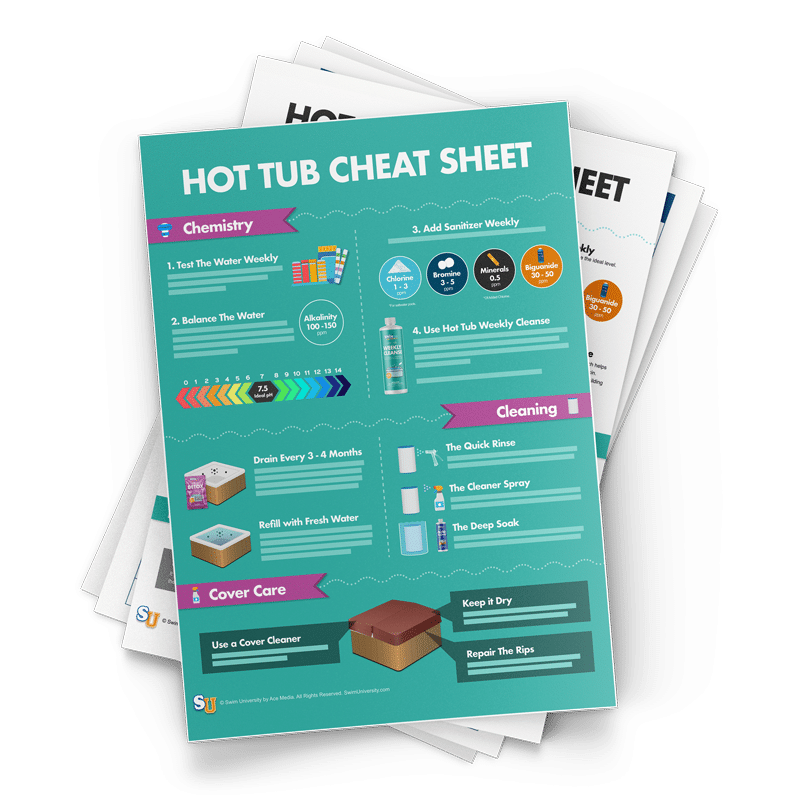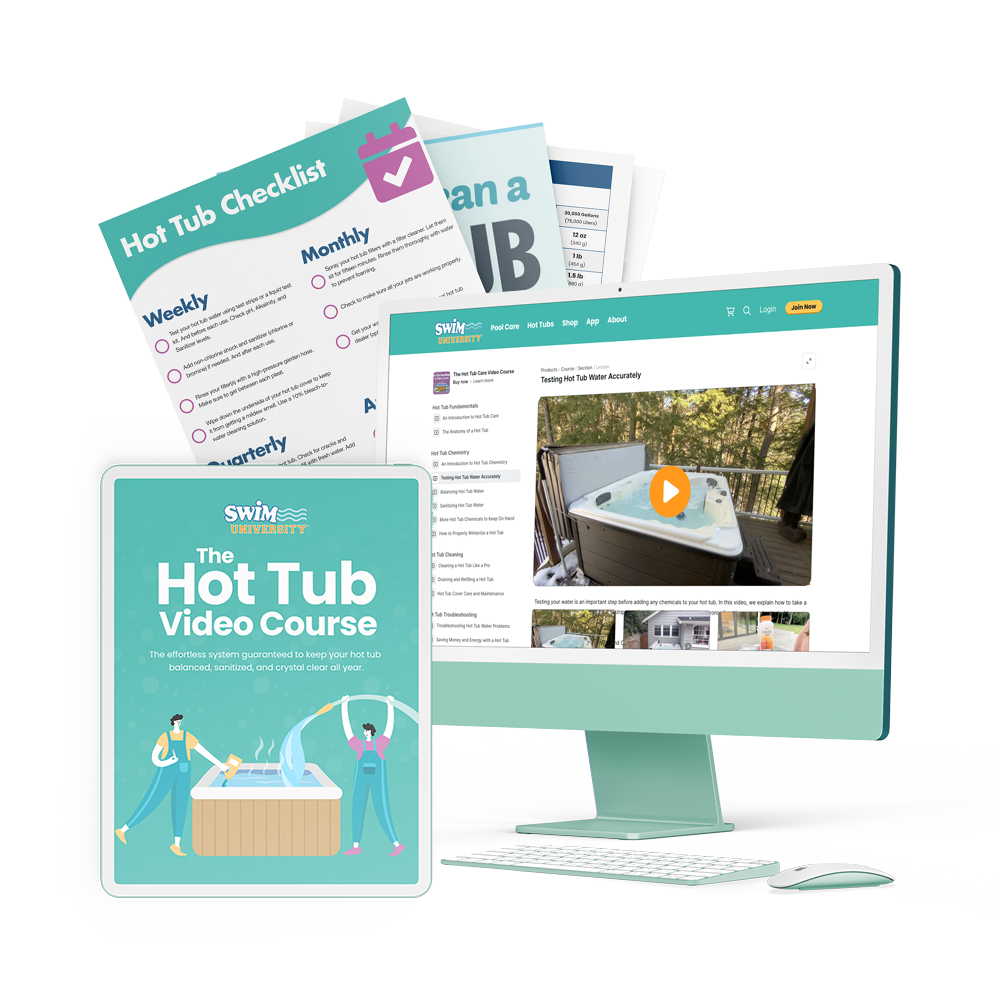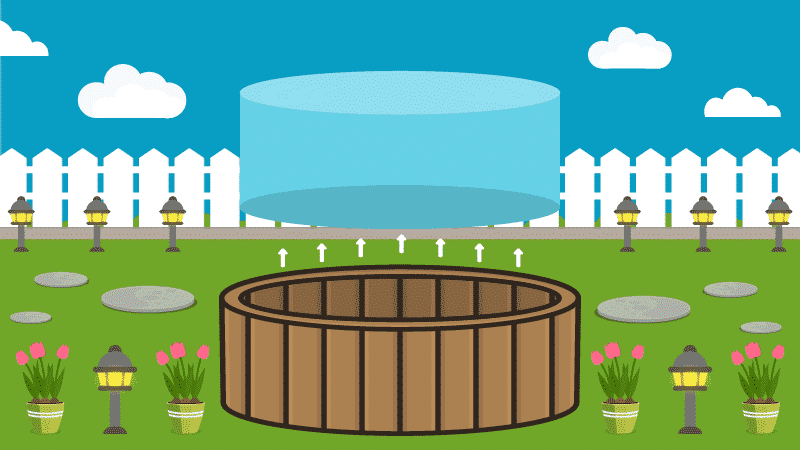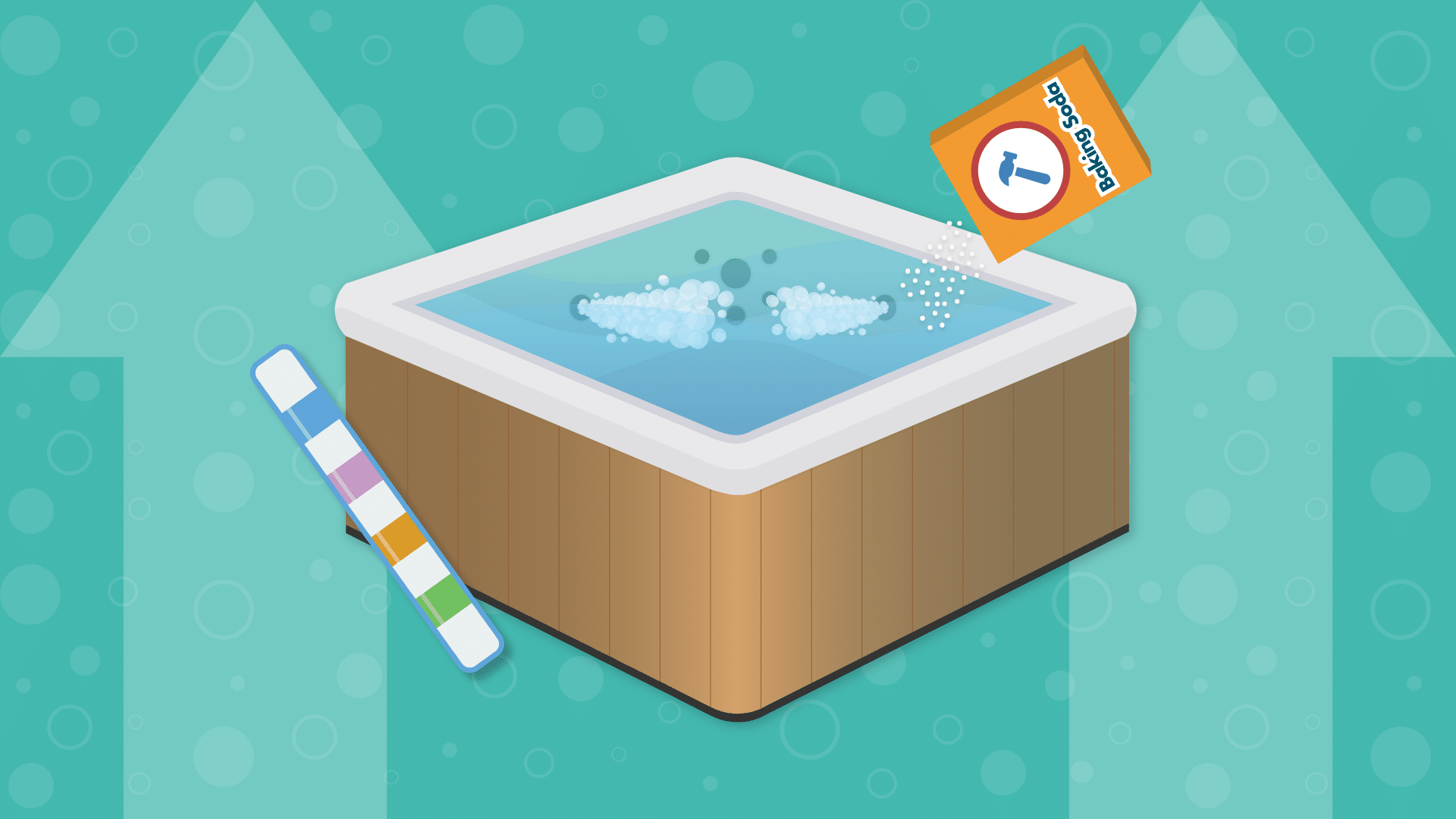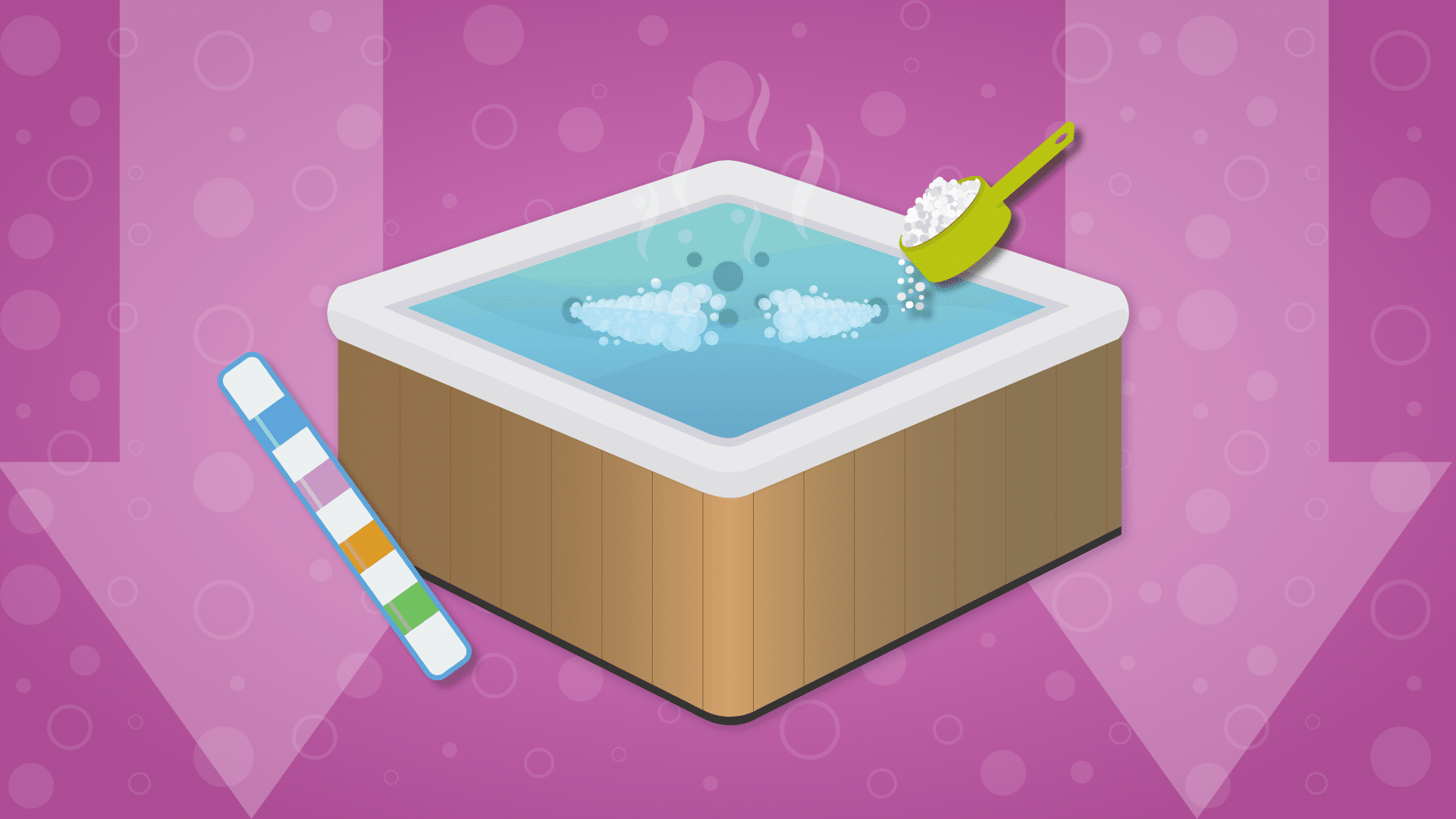Hot Tub Chemistry 101: What, When, and How to Add Chemicals
To keep your hot tub clean and safe to soak in, you need the right hot tub chemistry levels. But which ones? And when do you add them? And how much of each one do you need? And how do you actually add them to your hot tub?
Relax. It’s not as confusing as it may seem. Once you get a handle on the what, when, and how of spa chemicals, taking care of your hot tub will be easy.
My fool-proof system for keeping any hot tub clean and clear at all times. Our course covers every type of hot tub, including portable spas, inflatable hot tubs, inground hot tubs, swim spas, and more. This is the LAST and ONLY hot tub guide you'll need.
Do I Really Need to Use Hot Tub Chemicals?
Yes. Yes, you do. This isn’t like a bathtub that you fill, use, and immediately drain. The same water stays in your hot tub for weeks, sometimes months. Without chemicals to keep it sanitized, it would quickly turn into an incubation chamber for numerous organisms you definitely would not want to soak in.
If you were thinking you could just vacuum the tub once in a while, keep leaves and other debris out of the water, and that would be enough, you’re setting yourself up for a lot of cleanup work, potential equipment failure, and possibly even hot tub–related illness.
The key to preventing all of those things is using the right spa chemicals. We have a complete guide on what hot tub chemicals to buy. Or keep reading to learn more about using each chemical.
Hot Tub Chemistry: The First Step
You have three main questions about balancing your hot tub water. The first is, “What chemicals do I need for my hot tub?” The second one is, “How much of those chemicals do I use?” The only way to get the answers to both of those questions is to test the hot tub water, and there’s a lot to get through before you even consider the third question about how to add them.
The only way you’ll know which chemicals you need to add, and how much of each one is needed to balance the hot tub chemistry is to test your water. Be sure to keep test strips or, for more accuracy, a liquid test kit stocked and on hand at all times.
You can also take a water sample to a local pool and spa store and ask them to test it for you.
Once you have the baseline readings, you can start measuring and adding the right amounts of the necessary hot tub chemicals.
This complete water testing kit helps keep your pool or hot tub clean and safe to swim in, with easy-to-follow color instructions and all the supplies you need in one box.
Sanitizer
You could say this is the most important of all the spa chemicals you’ll use. After all, it’s what keeps your hot tub, well, sanitized.
The first thing to decide is which sanitizer you want to use, and you have a handful to choose from:
- Chlorine
- Bromine
- Biguanide
- Minerals
- Salt System
Each one has its pros and cons, so take the time to learn about them before making your choice.
Chlorine
Being the most common sanitizer, chlorine has a few advantages over the others:
- It’s cost-effective.
- It’s easy to add and manage.
- It’s an aggressive bacteria and algae killer.
In the same way you may use bleach to kill bacteria, fungi, and viruses in your bathroom, chlorine does all that for your hot tub water.
One drawback to chlorine can be the smell it gives off. Except it’s not the chlorine that smells. Chlorine kills contaminants by oxidizing and breaking down into its chemical components. As this chemical reaction occurs, the oxidation gives off waste products called chloramines. They’re what causes that “chlorine smell.”
If you can smell “chlorine,” it probably means you actually don’t have enough chlorine in your water because it’s been used up.
Test your water, and if the level is below where it should be, shock your hot tub to bring it back up quickly, get rid of the chloramines, and put the chlorine back to work killing contaminants.
Proper Chlorine Level: 1 part per million (ppm) to 3 ppm
Easy to add chlorine to your hot tub with granules (powder) and a cap that's perfect for measuring the amounts you add.
Bromine
Probably the second-most common sanitizer, bromine has one distinctive advantage over chlorine—it doesn’t oxidize, which means it doesn’t give off chloramines. Instead, bromine ionizes contaminants, breaking them apart at the molecular level.
The process produces a different waste product—bromamines. While they don’t smell and aren’t as noxious as chloramines, they still reduce the sanitizer’s effectiveness, and you don’t want them hovering around your hot tub. Keeping your bromine level steady will prevent this.
Bromine also has a few other advantages over chlorine:
- It has a lower pH than chlorine, making it a little easier to keep the water balanced.
- It lasts longer.
- It’s gentler on your skin.
Bromine does have a couple of drawbacks, though. While it lasts longer than chlorine, it also works more slowly, which means contaminants are in the water longer before they’re destroyed.
It’s also unstabilized, which means if you use it in an uncovered, outdoor hot tub, it’ll burn off pretty quickly under the sun. Unlike chlorine, which can be stabilized by cyanuric acid, bromine doesn’t have a stabilizing partner chemical. We think it’s best for indoor hot tubs, or at least ones that are outside but not in direct sunlight.
Proper Bromine Level: 3 ppm to 5 ppm
Biguanide
A non-chlorine sanitizer, biguanide (sold under brand names such as BaquaSpa) kills bacteria just as well as chlorine and bromine do. It has a few other advantages as well:
- It’s doesn’t need to be used as frequently as chlorine or bromine.
- It’s odorless at every stage.
- It makes the water feel smoother to you and your hot tub guests.
On the downside, biguanide usually costs more than chlorine and bromine. It’s also been known to cause deterioration in some spa parts like rubber gaskets and certain plastics. Check with your hot tub manufacturer before using it.
Proper Biguanide Level: 30 ppm to 50 ppm
Minerals
Silver is a known bactericide, and copper is a known algaecide. For these reasons, a hot tub mineral sanitizer uses one or both of them as active ingredients. Its biggest pro is also a bit of a con.
Using a mineral sanitizer means you can use less chlorine, which means the water won’t be as harsh on your skin. But you’ll notice we said less chlorine, not no chlorine. Minerals alone aren’t enough to properly sanitize water, so you must supplement with chlorine to get the full sanitizing effect.
Minerals are also on the less expensive side but remember you’ll be using two spa chemicals for sanitation rather than just one. That said, because you use so little chlorine, you also won’t have a problem with chloramines or the smell they produce.
Minerals are also super easy to manage. There’s no measuring out chemicals to add them to the water, and then waiting for them to disperse. They come in an automatically dosing “stick,” which you simply add to your filter and replace every three to four months. Be sure to follow the manufacturer’s instructions.
Proper Mineral Level: 0.5 ppm of chlorine or 1.0 ppm of bromine
Reduce the amount of chlorine (0.5ppm) you use in your hot tub by adding this mineral sanitizer to your filter system and let the power of minerals sanitize your water.
Salt Systems
You’ve heard of salt water pools, right? Well, you could have a salt water hot tub, too, if you wanted one. All it takes is a device called a salt chlorine generator.
You see, salt water hot tubs still use chlorine as a sanitizer. The generator converts the salt into chlorine, so instead of buying chlorine, you buy salt, which is a lot less expensive. The water will also be a lot softer and gentler on your eyes, hair, and skin.
To measure both salinity and chlorine, use test strips made for salt water.
Proper Salt Level: 2,000 ppm to 3,000 ppm, with 2,500 being ideal
Proper Chlorine Level: 1 ppm to 3 ppm (just like a chlorine spa)
Shock
Even if you’re keeping your sanitizer levels exactly where they need to be, your hot tub can benefit from a weekly shock (or more often, depending on bather load). But what makes this one of the most important hot tub chemicals around is its ability to give your hot tub some super sanitizing when it needs it.
Seeing algae starting to bloom in your spa? Did you wake up to a cloudy hot tub? Shock to the rescue! It’s not the only thing you’ll need to do, but it’s one of the more effective methods to quickly clear things up.
Chlorine Hot Tubs
You can use:
- Chlorine shock
- More chlorine
- Non-chlorine shock
Bromine Hot Tubs
You can use:
- Chlorine shock
- More bromine
- Non-chlorine shock
Mineral Hot Tubs
Because mineral systems use so little chlorine, we recommend using a non-chlorine shock to keep the chlorine levels low.
Biguanide Hot Tubs
If you’ve gone the alternative route, and are using biguanide as your sanitizer, be aware that those chemical systems have their own shock designed specifically for the brand you use.
Regardless of which sanitizer you use, your hot tub water’s alkalinity and pH will need to be balanced for the sanitizer to do its job.
Alkalinity
When balancing your hot tub chemistry, you’ll need to adjust alkalinity before trying to balance the pH level. Alkalinity acts as a pH buffer, keeping it from drastically changing.
It can be a delicate operation to get alkalinity levels just right, and if your water’s alkalinity gets too low—less than 100 ppm—it can also bring the pH level down, and the water will become acidic.
For this reason, you absolutely must keep an alkalinity increaser in your spa chemical storage cabinet.
But what if the alkalinity gets too high? Well, there’s actually no such spa chemical as alkalinity decreaser. To lower it, you’ll use a pH decreaser, which will lower both. This dependency and interaction is part of the difficulty in getting these two levels right. Here’s more information on lowering hot tub alkalinity.
Proper Level For Alkalinity: 100 ppm to 150 ppm (80 ppm okay)
Increase your hot tub total alkalinity with alkalinity increaser. Low alkalinity affects your pH and can stain and damage your hot tub surfaces and equipment.
pH
Once you have the alkalinity where it needs to be, turn your attention to the hot tub pH level.
Too-high pH is one of the main causes of cloudy hot tub water. If the level goes above 7.6, and you start to see problems, try using a
If it’s too low, break out the pH increaser, remembering that it will also raise the alkalinity, and you’ll have to test and possibly adjust that level again.
If both the pH and alkalinity levels are low, just adding alkalinity increaser will raise both, but make sure to adjust the pH if the alkalinity doesn’t bring it up to the correct level.
If both the pH and alkalinity levels are too high, use
While you’re adjusting alkalinity and pH, you may need to test the water numerous times to get everything right, so keep a supply of test strips on hand.
Important: Low pH and alkalinity can damage your hot tub because of the acidity of the water. High pH and alkalinity can cause scaling, which can also damage the equipment. The heater is at risk both ways. Acid due to low pH will eat away at the heater element, and high pH will deposit scale around the element, making it work harder to heat your hot tub.
Proper Level For pH: 7.4 to 7.6
Lower your hot tub pH with a pH decreaser. High pH can damage your hot tub equipment, cause cloudy water, and irritate eyes and skin.
Calcium Hardness
This is a measure of how hard the water in your hot tub is. If you live somewhere with hard water, you know how you get calcium deposits on faucets and showerheads and causes all kinds of problems? Well, it’s actually sort of the opposite in your hot tub.
You want the calcium hardness in your hot tub to be a little on the higher side. If it’s too soft, it can eat away at your hot tub shell, pipes, and other parts, slowly breaking them down over time. It’ll basically just wreak all kinds of havoc in the water. Sort of like what Mysterio did in Venice.
But what if the calcium hardness level somehow gets too high? That can make it difficult for the other hot tub chemicals you’re using to dissolve properly in the water, so it’s definitely a problem. It can also lead to cloudy water and scaling on your hot tub and its components, just like what happens to your shower head.
In this case, the best solution is to drain your hot tub, scrub it, and start over with fresh water.
To keep the calcium hardness steady and your hot tub healthy, keep a bottle of calcium hardness increaser with the rest of your hot tub supplies.
Proper Calcium Hardness Level: 175 ppm to 250 ppm
This product effectively safeguards your equipment from corrosion and etching by maintaining optimal calcium hardness levels, ensuring long-lasting protection and durability.
Hot Tub Enzymes
These naturally occurring substances help break down organic contaminants like skin cells, body oils, leaves, twigs, insects, all kinds of other nasties that can end up in your hot tub. If left too long, those contaminants will break down, and you’ll have to deal with a wicked case of hot tub scum.
Whether you use hot tub enzymes or not is really up to you. They’re not really necessary as long as you keep your sanitizer level balanced, and you drain, clean, and refill your hot tub on a regular basis, which is at least quarterly.
Water Clarifier
Heck, if we’re talking about keeping the water clean, why even worry about all those other hot tub chemicals?! Why not just use water clarifier?! Because it’s not a maintenance item—it’s a temporary measure.
Water clarifier treats the symptom, not the cause of cloudy water, so it’ll clear things up for a little while. But if you don’t address the actual problem, it’ll go right back to the way it was once the clarifier wears off.
So why have it? Well, say you’re planning a hot tub get-together, or maybe a romantic evening with your sweetie, and the water’s looking less than inviting. Instead of spending a lot of time on testing and balancing, you can just pour in some clarifier, and then deal with the root issue later.
But remember, it’s always preferable to keep your water clear and balanced.
Our hot tub kit makes taking care of your water easy. It includes Hot Tub Weekly Cleanse, Detox, and Filter Cleanse to use every 3-4 months for deep cleaning.
How To Add Hot Tub Chemicals
The third question you’ll ask is: “How do I add all these chemicals to my hot tub?” It’s easier than you think. You just need to follow a few simple steps.
Keep Your Hot Tub Running
You want the spa chemicals to mix into the water, and the hot tub jets will do this for you. But make sure your jets are on low and the air valves are off. Extra air in the water can raise your pH and oxidize your chemicals.
Do Not Cover Your Hot Tub
You might’ve heard this is a good idea to keep the chemicals from evaporating. Sure, that’s true on an everyday basis. But right after you add chemicals, they need to off-gas, which means the chemicals break down, and a portion of them is released into the air.
You know that new-car smell? Yeah, that’s actually all the new fabric and plastics off-gassing, so don’t enjoy it too much.
Anyway, off-gassing is normal, and you want those chemical gases to dissipate, so don’t trap them under your hot tub cover.
If your hot tub is outside, the gases will just dissipate into the air. But if your hot tub is indoors, it’s a good idea to open a window, or turn on a ventilation fan, or both, so those gases don’t hang around the room where you’ll have to breathe them in.
Turn Off the Air Valves
Speaking of off-gassing, you also don’t want this to happen too quickly. You need some of the chemicals to remain in the water to do their jobs. Too much air in the water, and too much of the chemicals will off-gas. So if your hot tub has air valves that increase jet pressure, turn them off.
Test the Water
Now, before you add any hot tub chemicals, you need to know what the water needs, and how much. To get this information, test the water using test strips or a liquid test kit.
Remember, the three main levels to be concerned about are alkalinity, pH, and sanitizer. If your alkalinity and pH are out of whack, the sanitizer can’t do its job.
Follow the Instructions
Refer to the manufacturer’s instructions on every chemical’s packaging to figure out how much of the chemical you need to either raise or lower the specific factor it’s going to address.
Measure Twice, Pour Once
Once you’ve determined which spa chemicals you need to add and how much, measure them out. You don’t want to just pour chemicals into your water straight from the container. Remember, the goal here is balanced water, not a chemical crapshoot.
Add the Hot Tub Chemicals
Finally, just pour the measured chemicals straight into the hot tub water, and walk away. The jets will mix everything up. Leave it for at least 20 minutes, then you can cover your hot tub to prevent evaporation.
Before you get into the hot tub, test the water again to make sure the levels are where they need to be. If they’re not, repeat this process until they are.
Tests for 7 important chemistries in seconds: Total Hardness, Total Chlorine, Total Bromine, Free Chlorine, pH, Total Alkalinity, and Cyanuric Acid.
Only You Can Prevent a Dirty Hot Tub
Aside from keeping your water balanced and having the right spa chemicals on hand to clear your water when necessary, you can do a few other things to keep your hot tub clear.
Keep Your Hot Tub Clean
Duh. Seems like common sense, right? But hey, we all get lazy from time to time, or we procrastinate. We’re human. But this is one area where slacking can get you into more trouble than just not-so-clear water.
Use a good hot tub cleaner on a regular basis to keep things sanitary, and your water sparkling.
This weekly hot tub treatment cleans, conditions, and makes your water clear all at once. It stops gunk from building up in your pipes and jets while making the water feel soft and silky. Just add a little bit with the jets on high to keep any type of hot tub fresh and clean.
Shower Before Every Soak
This should also be common sense, but an alarming number of people will just jump right into a hot tub (or pool) without a shower (or at the very least a quick rinse-off) because they figure the sanitizer will just take care of everything.
Sure, that’s what sanitizer is for. But it only does so much. Put too much burden on it, and it becomes a lot less effective. Do your part and help your sanitizer out by showering before you soak. This is even more important when you’re a guest in someone else’s hot tub. Or when someone’s a guest in yours.
Need another reason? We have two words for you: gluteal fold. We’re gonna let the Water Quality and Health Council explain that one.
Keep Your Filter Clean
The filtration system in your hot tub has a tough job. It’s there to remove everything from small bits of debris to bacteria (depending on the type of filter you have) from the water to keep you safe and healthy.
But if you’re not cleaning it regularly, you’re making it a lot more difficult for the filter to do its job. It can’t grab all the debris and gunk if it’s already full of debris and gunk. Do your filter, your hot tub, and yourself a favor by cleaning it regularly.
Soak your hot tub filters in this deep-cleaning solution, rinse with water, and your filters will look brand new in 24 hours!
Change Your Filter When Necessary
Even if you clean it regularly, your hot tub filter will still need to be replaced eventually. Keep an eye on its condition when you remove it for cleanings and replace it when cleaning isn’t enough to get it clean anymore.
Use Hot Tub Sponges or Tennis Balls
Remember those organic substances we talked about floating on top of the water, creating a nasty ring of scum in your spa shell? Tossing a couple of hot tub sponges or a few tennis balls into the water will help keep that film at bay. The sponges or the tennis balls’ fuzzy exterior will soak up some of the oil and other things that can cloud your water.
Just remember, they won’t work forever. While you can wash them and keep using them for a while, just like anything else, they’ll eventually need to be replaced.
Keep Your Hot Tub Covered
Whether your spa is outside and exposed to leaves and bugs, or inside and exposed to dust and maybe a too-curious dog, using a hot tub cover will help keep things out that can dirty your water.
This also means less work and fewer chemicals, which translates to less money spent on maintaining your hot tub. If you don’t have a cover, get one.
Drain and Clean Your Spa on a Regular Basis
So you’re already cleaning your hot tub regularly. That’s great! But you know you can’t just keep the same water in there forever, right? Think about that for a minute. Do you really want to?
At least quarterly, drain and clean your hot tub. This is also the perfect time to use a line flush product to get rid of any biofilm that may be lurking in your plumbing. Give it a good scrubbing, refill it with clean, fresh water, and off you go again.
Don't let your hot tub fill with hard-to-remove gunk. Clear out the gunk and keep your hot tub water fresh. It removes gunk in your pipes caused by lotions, sunscreens, cosmetics, etc.
You Passed Hot Tub Chemistry 101!
Keeping your water clear isn’t always about using spa chemicals. A big part of it is simply taking good care of your investment. Hot tubs are not cheap. The better you maintain yours, the longer it will last, and the more you’ll be able to enjoy it.
And you’ll be better able to maintain it if you have the right hot tub chemicals and equipment available. So don’t skimp. Get what you need, and use it. Your hot tub will repay you by always being ready when you want to relax.
3 More Ways We Can Help With Your Hot Tub
- Hot Tub Cheat Sheets (Free): Easy-to-use guides to help you keep your hot tub water balanced and sanitized.
- The Hot Tub Handbook: An illustrated guide to DIY hot tub care, including water chemistry, maintenance, troubleshooting, and more.
- The Hot Tub Care Course. You’ll get step-by-step videos and a step-by-step downloadable guide with everything you need to know about hot tub maintenance.
